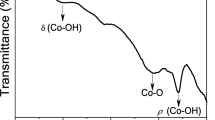Abstract
The voltammetric responses of copper and silver had been extensively studied and compared in a variety of non-aqueous solvents such as acetonitrile (AN), propylene carbonate (PC) and sulfolane containing two different supporting electrolytes namely triethylaminetrishydrogen fluoride (TEA.3HF) and tetrabutylammonium tetrafluoroborate (TBABF4). The dissolution rate and surface transformation on the electrode surfaces as a result of anodic polarization was investigated using atomic absorption spectroscopy (AAS) and scanning electron microscopy (SEM), respectively. In solvent-free TEA.3HF medium, the copper electrode shows high charge recovery ratio (Q c/Q a), and the difference between the initial anodic and cathodic potentials, obtained at a current density of 2 mA cm−2, is around 0.11 V, suggesting that in this medium, Cu can certainly serve as reference electrode. On the other hand, on Ag electrode, substantial dissolution was observed leading to very high anodic (Q a) and cathodic (Q c) charges, and the surface morphology after the cyclic polarization results in roughened surface with large pores. The effects of incorporating AN and water as additives in TEA.3HF on the solubility and stability of these metal fluoride films are also reported. The dissolution pattern and film formation behavior of these two metals in the different solvents containing fluoride and fluoroborate ionic species have several qualitative similarities, as noted from cyclic voltammetry responses and SEM morphology. Anodic dissolution and precipitation process for both Cu and Ag depends significantly on the nature of supporting electrolytes as well as solvents. In AN containing 0.1 M TEA.3HF, the dissolution of Cu and Ag electrodes was very high. Fluoride salts of Cu show lesser solubility than Ag in those solvents, while fluoroborate salts exhibit the reverse trend. The AAS data suggest that for a particular salt, which may be either fluoride or fluoroborate of Cu and Ag, the relative solubility decreases in the order AN > PC > sulfolane.










Similar content being viewed by others
References
Suriyanarayanan N, Noel M (2005) J Appl Electrochem 35:49
Burrows B, Jasinski R (1968) J Electrochem Soc 115:348
Germanz G, Nicolas F, Rouquette S, Lamirault S, Ferry D, Picard GS (1989) Mater Sci Eng 120–121:329
Dumont H, Qian SY, Conway BE (1997) J Appl Electrochem 27:267
Mimoto A, Miyazaki T, Yamashita J, Nagamine S, Inaba M, Tasaka A (2006) J Electrochem Soc 153:9
Filliaudeau DJF, Picard GS (1993) Electrochim Acta 38:1951
Dove MFA, Goodier M (1991) J Fluorine Chem 54:23
Totir GG, Chottiner GS, Gross CL, Scherson DA (2002) J Electroanal Chem 532:151
Noel M, Suriyanarayanan N, Suryanarayanan V (2001) J Solid State Electrochem 5:419
Devynck J, Fabre PL, Tremillion B Benhadid A (1978) J Electroanal Chem 91:93
Gatner K, Zieba A (1995) Polish J Chem 69:1315
Sneddon DD, Gewirth AA (1995) Surf Sci 343:185
Zhang SS (2006) J Power sources 162:1379
Zhang SS, Xu K, Jow TT (2006) J Power sources 156:629
Noel M, Suryanarayanan V, Chellammal S (1997) J Fluorine Chem 83:31
Fuchigami T, Higashiya S, Hou Y, Dawood KM (1999) Rev Heteroatom Chem 19:67
Acknowledgments
The authors thank the Director, CECRI, Karaikudi for his keen encouragement in doing this work. The authors acknowledge the assistance of Ms. M. Deepa and Ms. A. Jasmine during the preliminary stage of this investigation.
Author information
Authors and Affiliations
Corresponding author
Rights and permissions
About this article
Cite this article
Suryanarayanan, V., Noel, M. A comparative evaluation on the anodic behavior of Cu and Ag electrodes in non-aqueous fluoride and fluoroborate media. J Solid State Electrochem 13, 1913–1923 (2009). https://doi.org/10.1007/s10008-008-0773-2
Received:
Revised:
Accepted:
Published:
Issue Date:
DOI: https://doi.org/10.1007/s10008-008-0773-2




